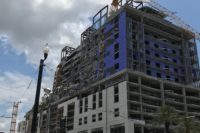OSHA Cites Engineer, 10 Contractors for Violations Before Hard Rock Collapse

An October 2019 shot of the New Orleans Hard Rock Hotel collapse.
Photo by Autumn Cafiero Giusti
The Occupational Safety and Health Administration has cited the lead engineer and 10 other contractors a total of $314,000 for violations leading up to the Oct. 12, 2019, collapse of the New Orleans Hard Rock Hotel while it was under construction. Three workers were killed and dozens of others were injured when the upper floors of the 18-story hotel collapsed. Two bodies remain in the rubble.
Structural engineer Heaslip Engineering LLC received the most severe penalties—$154,214 in fines, about half of the overall total—for what the federal agency classifies as “willful” and “serious” violations that compromised the building’s structural integrity. OSHA cited the other 10 companies, including general contractor Citadel Builders and steel contractor Suncoast Projects, for various safety violations. OSHA did not cite the developer, 1031 Canal Development LLC, in the March 26 report.
In the only “willful” violation the agency named in its March 26 report, OSHA cited Heaslip for structural steel connections that were “inadequately designed, reviewed or approved, affecting the structural integrity of the connections.” OSHA defines a “willful” violation as one “in which the employer either knowingly failed to comply with a legal requirement (purposeful disregard) or acted with plain indifference to employee safety.”
OSHA cited the engineer for “serious” violations including floor beams on the 16th floor that were not designed to bear the load they were supporting, vertical beams on the 17th and 18th floors that were spaced too far apart and sections of the building’s upper floors that were not properly tied into the structure.
According to OSHA, a “serious” violation is “when the workplace hazard could cause an accident or illness that would most likely result in death or serious physical harm, unless the employee did not know or could not have known the violation.”
Heaslip’s attorney, Kelly Theard of Deutsch Kerrigan, issued a statement refuting the citations. “Heaslip Engineering has an impeccable record and reputation for providing quality engineering services on hundreds of projects over two decades. Our firm has reviewed the citations from the Occupational Safety and Health Administration and adamantly disputes the findings. We believe OSHA’s conclusions are unwarranted, not supported by the facts and beyond the jurisdiction of OSHA’s statutory authority. Heaslip unequivocally denies any ‘willful’ or ‘serious’ wrongdoing, and will vigorously contest all of the citations through the procedures required by OSHA.”
Suncoast Projects was cited for “serious” structural and safety violations related to the building’s structural integrity and faces $36,434 in fines. OSHA claims that on the day of the collapse, “employees performed steel erection activities where steel beams were not connected to columns on the 15th floor per the contract documents and did not meet the specific load requirements,” putting workers at risk of being struck or crushed.
Citadel Builders, which is also a partner in 1031 Canal Development, faces $28,338 in fines for “serious” safety violations that include failing to provide visibly marked exits or temporary stairways workers could have used to get out of the building.
The other firms cited in the report include: Regional Mechanical Services LLC, fined $9,446; King Co. LLC, fined $12,145; F. Mata Masonry LLC, fined $12,723; Rush Masonry Inc., fined $9,446; HUTCO Inc., fined $10,794; REY.CO Inc., fined $22,940; S&S Construction and Consulting LLC, fined $8,096; and Southern Services and Equipment Inc., fined $9,446.
Completing Demolition
For months, discussions have been in the works on how to best demolish what remains of the collapsed structure. Two tower cranes were successfully brought down in a controlled demolition a week after the collapse, but no other demolition work has taken place. Officials say the structure is unstable, and workers have been unable to safely recover the two bodies still inside.
Demolition contractor Dem/Tech, an affiliate of Kolb Grading, had initially planned a controlled demolition of the hotel using explosives. But that plan was soon switched to a more conventional demolition, in which the building would be stabilized using temporary supports and shoring while workers took it down piece-by-piece. This change of plan pushed the schedule back to at least December 2020.
In January, the city of New Orleans announced plans for the hotel to come down in late March a controlled demolition by D.H. Griffin Cos., the same firm that brought down the two tower cranes.
Now, it appears demolition plans have been met with new setbacks and uncertainties. In a March 29 court filing, D.H. Griffin indicated that it wants out of its discussions with the developer, as insuring the project has become difficult and expensive. The demolition agreement between D.H. Griffin and 1031 Canal hinged on the demolition company obtaining $50 million in liability insurance and the state indemnifying the company for any additional liabilities. But in January, the state said it would no longer indemnify the D.H. Griffin, and the firm was able to secure only about $22 million in liability coverage.
This week, 1031 Canal publicly indicated that it has worked out a new deal with Kolb Grading to dismantle the building in a traditional demolition, and that the plan was just waiting on a green light from the city. City officials, however, voiced their disapproval of this plan. The city has long favored implosion as the safest method for taking down the building.
Representatives of D.H. Griffin, 1031 Canal and the city of New Orleans did not return requests for comment by press time.



